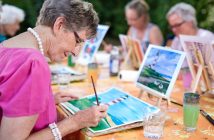Not every person struggling with dementia lives in a nursing home or assisted-living facility.
In fact, more than 15 million Americans—usually family members or friends—provide unpaid caregiving to people with Alzheimer’s disease and other forms of dementia, according to a 2014 report by the Alzheimer’s Association.
Although it’s wonderful so many are willing to assume that responsibility, it’s also important they take steps to make sure the home is a safe place, says Kerry Mills, co-author with Jennifer Brush of the book “I Care: A Handbook for Care Partners of People With Dementia.”
Part of that is to focus on potential hazards. The concept is not unlike new parents making a house childproof. Many of the concerns are similar, such as stairs, electrical sockets, sharp objects, and swimming pools.
At the same time, it’s easy to go too far, Mills said. Ideally, the environment for the person with dementia should be as unrestricted as possible.
“For example, if your loved one enjoys cooking for a hobby and can safely cut and peel vegetables, then by all means, encourage it,” Mills says.
Mills suggests several ways to make a home safer for someone with dementia.
Front and back doors
Use bells on the doors, motion sensors that turn on lights or alerts, or other notifications that make the care partner aware when someone has gone out. Add lamps or motion-activated lighting so people can see where they are going when they are entering or leaving the house.
“Another way to discourage someone from wanting to leave the house is to make sure that he or she gets plenty of outside exercise whenever possible,” Mills says.
Stairways and hallways
Add reflective tape strips to stair edges to make stairs more visible. Remove obstacles, such as mats and flowerpots, to minimize risks of falls on or by the stairs.
Also, install handrails in hallways and stairways to provide stability, and install a gate on the stairway to prevent falls. Improve the lighting around hallways and stairs by installing more ceiling fixtures or wall sconces.
Bathrooms
Install grab bars and a raised toilet seat to help both the individual with dementia and the care partners so they don’t have to lift the person on and off the toilet.
Add grab bars inside and outside the tub, and a non-skid surface in the tub to reduce risks of falls. You can also add colored tape on the edge of the tub or shower curb to increase contrast and make the tub edge more visible.
Lower the water temperature or install an anti-scald valve to prevent burns, and remove drain plugs from sinks or tubs to avoid flooding.
Wandering
Provide your loved one with an identification or GPS bracelet in case he or she wanders. Label clothes with the person’s name, and place an identification card in his or her wallet with a description of the person’s condition. Notify police and neighbors of the person’s dementia and tendency to wander.
About Kerry Mills
Kerry Mills, MPA, is an expert in best care practices for persons with dementia both in the home and in out-of-home health care residences and organizations. She is a consultant to numerous hospitals, assisted livings, hospice, home care agencies, senior day care centers and nursing homes. In her twelve-year career in health care, she has served as executive director and regional manager for numerous long-term dementia facilities. She is an outspoken advocate for persons with dementia, lecturing in Hong Kong, Canada, China, Europe and the United States. Her book, coauthored with Jennifer A. Brush, “I Care,” (engagingalzheimers.com), is the 2014 Gold Award Winner of the National Mature Media Awards.





